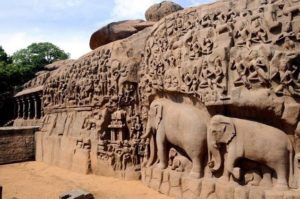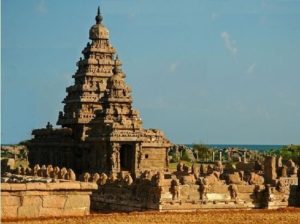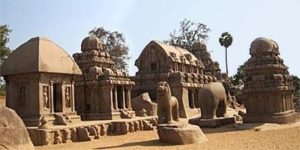Pallava Architecture
Pallava Architecture
Q) Describe the salient features of Pallava Architecture with special reference to cave and structural temples.
Structure: Direct question: fulfil the demand of the question
In the beginning of the medieval period, the Kings did not directly patronize the religious shrines and gave only indirect support. Most of the artworks were produced by the guilds of the artists who were actually funded by the villages, traders and and monks. The tradition of direct patronization of the temples began with the Pallavas.
Under the ablest kings such as Mahendravarman, Pallavas extended their territories to the Tamil Nadu. From the time of great Mahendravarman, finest examples of Pallava art were created in Tamil Nadu such as Shore Temple and 7 pagodas of Mahabalipuram.
Salient Features of the Pallava Architecture
- The Pallava architecture shows the transition from the Rock Cut Architecture to the Stone built temples.
- The earliest examples of the Pallava art are the rock cut temples of the 7th century AD, while the later examples are of structural temples built in 8th and 9th century.
- The rock cut reliefs of the Pallavas are the earliest surviving royal portraits after the Kushana images.
At the end of 6th century, King Harsha ruled in the North and he patronized the Buddhist Institutions. In South, Pallavas expanded themselves from the much of the Andhra Pradesh of today to much of Tamil Nadu. The Pallava Kings are known to be one of the greatest patrons of the art, music, architecture, dance and literature. King Mahendravarman was a poet and a playwright who wrote a satire on contemporary life titled “Mattavilasa Prahasana“. Another King of Pallava Dynasty named Rajsimha (Narsimhamvaraman) was such a great lover of art that he used the title “Kalasamudra” for himself.
- The glory of the Pallavas still remains in their contribution to the art and architecture

- They were the pioneers of South Indian art and architecture
- Their contributions are still extant because granite was used for building temples and carving sculptures
- The Pallava architecture had evolved stage by stage from the period of Mahendravarman I
We can broadly classify the Pallava architecture as:
- Rock-cut
- Monolithic Rathas and Sculptural Mandapas and
- Structural
Rock-cut temple
- We call the Pallava rock-cut temples as Mahendravarman

- He carved temples out of the rocks and thus they were known as rock cut temples
- It was really an innovation in the sphere of art because he did not use any other building materials. Therefore, he was hailed s Vichitra Chitta.
- In these rock cut temples, we find the sanctum sanctorum and on the walls of it beautiful sculptures
- The pillars are carved in such a way that they stand on the heads of lions
Monolithic Rathas
- The monolithic rathas and sculptural mandapas constitute the Mamalla style of architecture
- The Pallava king, Narasimhavarman I was known as Mamalla. He had converted the port of Mamallapuram as a beautiful city of art and architecture.
- The Monolithic rathas at Mamallapuram are now called as Pancha Pandava
- Each ratha or chariot was carved out of single rock and hence the name monolithic

- These rathas depict the five different forms of temple architecture
- The mandapas or halls at Mamallapuram had also belonged to the Mamallan Each mandapa was carved out of single rock. On the side- walls of these mandapas, beautiful sculptures depicting Puranic stories had been carved. The scene depicting the Goddess Durga’s attack on Mahishasura is seen in the Mahishasura Mardhini Mandapa.
- The most important among the Mamalla style of architecture is the Open Art Gallery. Several miniature sculptures have been carved beautifully on the wall of a big rock.
- The fall of the River Gange from the head of God Siva and the Arjuna’s penance are notable among them.
- The images of deer, monkey, cat, mouse and other animals are beautifully carved on this huge rock
Structural Temples
- From the reign of Rajasimha, the construction of structural temples had started
- These temple structures were built with the use of granite slabs. Hence, they are known as structural temples
- We can broadly classify the Pallava structural temples into Rajasimha Style and
- Nandivarman Style
- The earliest among the Pallava structural temples were the Kailasanatha Temple at Kanchipuram and the Shore Temple at Mamallapuram
- These temples were built by using sandstones
- The Vimana or tower of the Kailasanatha temple is shaped like hilly This temple is considered as the Crown of Pallava architecture. This temple is also called as Rajasimheswaram.
- We also find beautiful sculptures in this temple. The sculptures depicting the scenes of the satirical drama Maththavilasa Prakasanam have been engraved in this temple
- The Shore temple at Mamallapuram is also filled with numerous sculptures
- The successors of Rajasimha had also built several structural temples at various places. Nandivarman II had built the Vaikunda Perumal Temple at Kanchipuram
- The temples built by the later Pallava rulers are found at places like Kanchipuram, Panamalai, Kooram, Thiruthani and Gudimallam
Fine Arts (Additional reading)
The Pallava kings had also patronized fine arts. The Kudumianmalai and Thirumayam music inscriptions show their interest in music. Yaazhi, Mridhangam and Murasu were some of the musical instruments of the Pallava period. Both Mahendravarman I and Narasimhavarman I had remained experts in music. The temple sculptures of the Pallava period reveal that the art of dance was popular in those days. The paintings at Chittannavasal illustrate the nature of Pallava painting Mahendravarman I was known as Chittirakkarapuli. He had also composed the book, Thatchina Chitram. We have already seen that he was the author of the satirical drama Maththavilasam Prakasanam, Thus, music, dance, paintings and drama were popular during the Pallava rule. In this way, the Pallavas had contributed to the growth of culture

